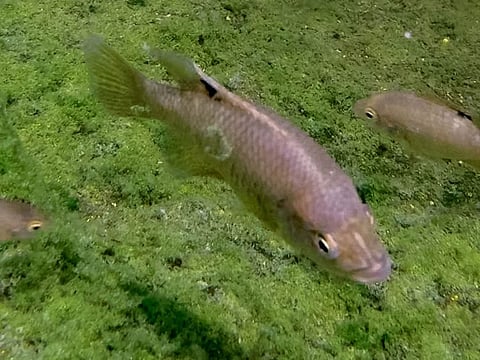Sharjah Safari breeds rare Madagascar Paratilapia fish
Visitors can explore 12 different environments inspired by various parts of Africa

Sharjah: Sharjah Safari, home to about 50,000 animals and is the largest safari outside Africa, announced a successful breeding project of the rare “Madagascar Paratilapia (Paratilapia Polleni)” fish, listed as endangered by the International Union for Conservation of Nature (IUCN).
This achievement reflects the commitment of the Environment and Protected Areas Authority in Sharjah (EPAA) to protect this exceptional species within the 8-square-kilometre safari.
Hana Saif Al Suwaidi, Chairperson of the Environment and Protected Areas Authority in Sharjah (EPAA) highlighted the combined scientific, research, and practical efforts behind Sharjah Safari.
She said: “The Safari team’s success in breeding the rare Madagascar Paratilapia fish exemplifies our commitment to vision and directives of His Highness Sheikh Dr Sultan bin Muhammad Al Qasimi, Supreme Council Member and Ruler of Sharjah. Sharjah Safari is a scientific and research project aimed at multiplying endangered species and enriching visitors’ knowledge through twelve different African environments showcasing diverse terrains, animals, birds, and fish.”
Spiny Forest
Al Suwaidi added, “At Sharjah Safari, not only we do care for large mammals, but we also pay attention to small fish that play a significant environmental role in nature, such as this rare fish.”
Elaborating further, she explained, “The Madagascar Paratilapia fish lays its eggs in water-bushes or mud where they remain for 3-4 days, after which the larva remains hidden for a few weeks. We are now observing young fish in the Spiny Forest area in Sharjah Safari by successfully implementing this process.”
Madagascar Paratilapia
Approximately 5cm in size, Madagascar Paratilapia (Paratilapia Polleni) feed on fish flakes and blood worms. The fish likes to hide among aquatic plants, and its primary habitat is northern Madagascar. The species faces genuine threats, including deforestation, habitat degradation, and changes in mature fish colour during mating seasons. Adult male fish are much larger than females and possess longer fins.
The species faces genuine threats, including deforestation, habitat degradation, and changes in mature fish colour during mating seasons. Adult male fish are much larger than females and possess longer fins.
Al-Suwaidi expressed her appreciation to the Sharjah Safari staff for their scientific research and practical efforts in achieving the safari’s goals and to affirm its status, value, importance, and role in bringing the world of Africa to Sharjah.
She hopes the safari will continue to become a scientific and educational destination for all.
Environmental tourism
Sharjah Safari, opened on February 17, 2022, has received an enthusiastic response from environmental tourists, nature lovers, families, and students.
Visitors can explore 12 different environments inspired by various parts of Africa and covering an area of 8 square kilometers — distributed across Into Africa, Sahel, Savannah, Serengeti, Ngorongoro, Moremi, Kalahari, and Niger Valley to represent the life and terrain of Africa.
50,000 animals
These areas represent life and terrains, imitating the regions of Africa and are home to more than 50,000 animals, with over 120 species of animals residing within Al Bridi Reserve in Al Dhaid.
Since its opening, Sharjah Safari has succeeded planted more than 100,000 trees, including 100,000 African trees.
The types of plants vary across a wide spectrum of local and African species, making it a unique tourist attraction in the UAE and the region.
Sign up for the Daily Briefing
Get the latest news and updates straight to your inbox




